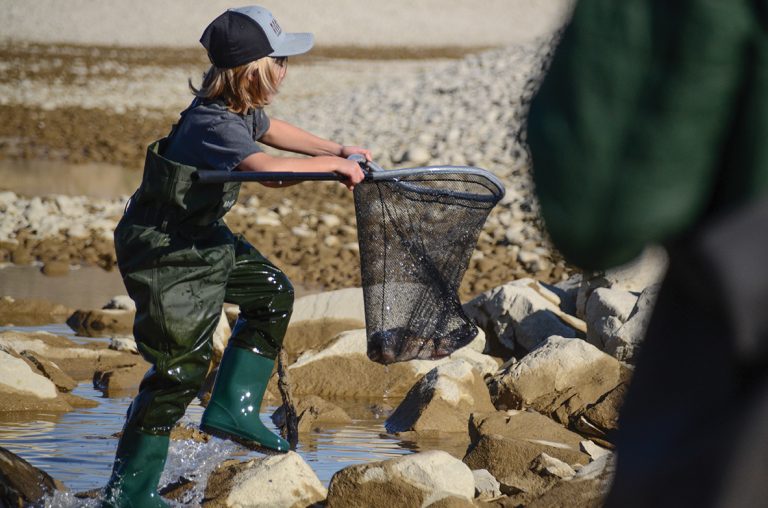The hidden cost of irrigation: PFAR’s annual fish rescue exposes gaps in Alberta’s environmental protections

Avorie Hunderson measures a brown trout, the largest catch of the day at 55 cm, using her skills learned in fisheries classes. Somya Lohia
By Somya Lohia, Local Journalism Initiative Reporter
In a unique blend of tradition and conservation, dozens of people gathered Saturday near Buffalo Rock Tipi Camp in Piikani Nation to participate in the annual Peigan Friends Along the River fish rescue.
This drive, founded by Harley Bastien in 1990, aims to save fish trapped in the irrigation canal after water levels drop each fall.
The canal, which supplies water to the Lethbridge Northern Irrigation District, inadvertently traps fish that enter through its headgates from the Oldman River. As water is released, fish are left stranded in the nearly one-kilometre-long flume or aqueduct with no way to return to the river without human intervention.
Peigan Friends Along the River gathers volunteers to capture as many fish as possible and return them to their home waters to carry out their life cycle.
“As a part of my culture, we believe everything in the eyes of the Creator has a right to be alive,” Bastien told Shootin’ the Breeze.
He estimates more than 250,000 fish have been rescued over the past 33 years.

The rescue process involved using nets to move fish from one end of the flume to the other. At the end, people of all ages anxiously waited with nets and buckets to catch the fish.
“We gather here annually. We catch all the fish that are in the canal and the aqueduct, and we transport them back to the river,” Bastien said.
Once the fish were caught, they were hoisted out of the flume to be identified, measured and counted. After this, they were placed in stock tanks or oxygenated holding tanks, depending on their size.
“We have various tanks here for different sizes of fish: the minnow, the juveniles and the large fish,” Bastien explained.
“We have an oxygenated tank here for larger fish, to keep them alive. For the smaller ones, we pour more water in stock tanks that adds more fresh oxygen to the water.”
The holding tanks were then driven down to the edge of the Oldman River on the Buffalo Rock Tipi Camp.

Before releasing the rescued fish into the river, Elder Orlando Calling Last performed a blessing. He offered tobacco to the water, requesting it to welcome the fish back, and sang a song.
Bastien also expressed gratitude to the volunteers for participating in the drive.
“On behalf of all the fish here, I say thank you to all.”
Following this, the fish were released back to the Oldman River, ensuring their life cycle continues in their natural habitat.
Volunteers from across Alberta and neighbouring states had joined in to help.
“Volunteers are coming from Calgary, Fort Macleod, Cardston, Montana, etc. They come from all over the country,” Bastien said.
Among the volunteers were Avorie Hunderson, a student of renewable resource management at Lethbridge Polytechnic.
Involved in the event for the past three years, she applied her skills from fisheries classes to measure and identify the rescued fish.
“I have different fisheries classes where we learn to identify the species and handle them,” Hunderson said.
“I have been doing this for three years now. I usually help with the pushes, but this year I got to help with measuring and identifying fish, which was super fun.”
Hunderson estimated that around 200 fish were saved during this year’s event, including a brown trout that measured 55 centimetres, the largest fish she encountered that day.
Ten-year-old Charlie Wright came with her mother, Beth, from Nanton to rescue fish.
“It’s my second time and it feels good to participate,” she said.
Symone Yellow Horn from Piikani Nation joined the drive for the first time, along with husband Trevor Warrior and son Sacha Warrior.
Asked about their experience, she said, “It was fun and educational. We’d like to come again.”
In addition to its ecological importance, the event highlights a longstanding problem that Bastien and others believe warrants government intervention. Currently, no fish exclusion gate exists to prevent fish from being drawn into the canal.
“The provincial government is aware that this is happening but they just turn a blind eye. To them, it’s just a few fish,” Bastien said.
The event also sheds light on the larger economic context. Bastien said no funding or assistance has been offered to Peigan Friends Along the River for its conservation work.
“I raise all the money myself. I pay for everything, and we do it all ourselves,” he said, noting that the task of organizing hundreds of volunteers each year falls squarely on his shoulders.
The annual fish rescue is not just a community effort but a testament to the people’s commitment to conservation and respect for life.
